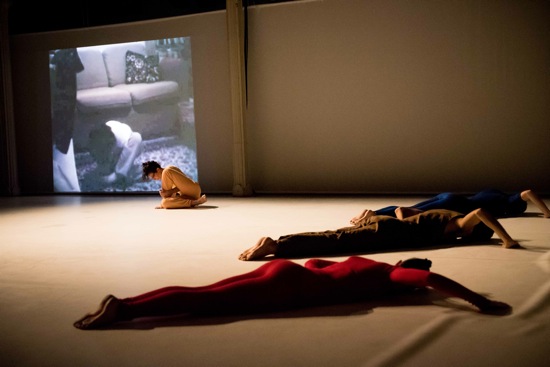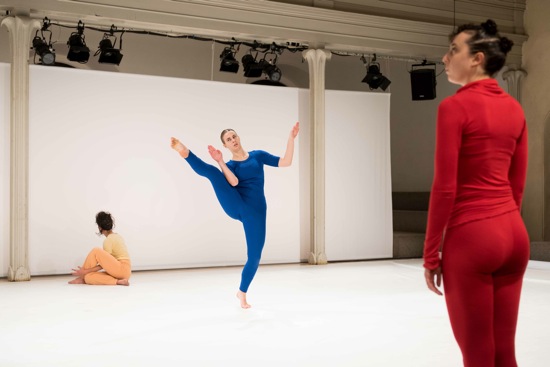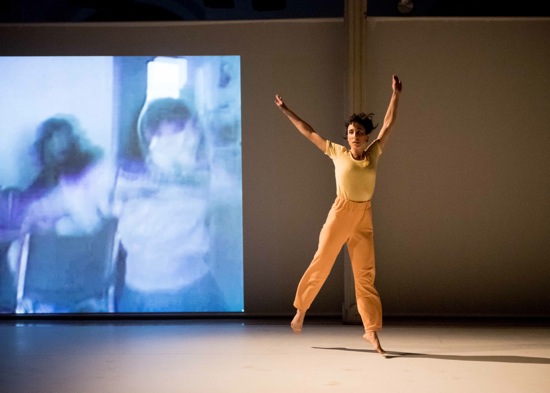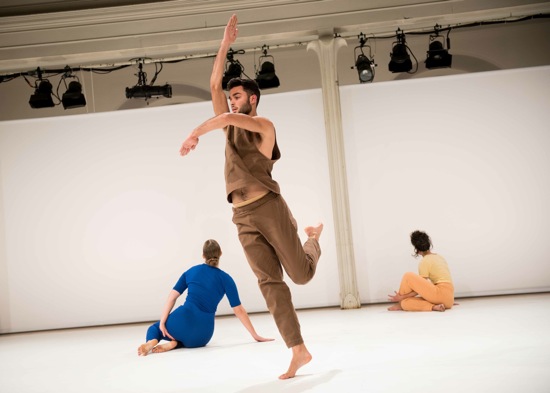Netta Yerushalmy presents Helga and The Three Sailors at Danspace St. Mark’s
Here are some thoughtful words that dancer Neal Beasley wrote about choreographic logic, especially as it pertains to Netta Yerushalmy’s new Helga and The Three Sailors: “There is a perverse solace in the inability to hold on to anything or make oneself understood. Such is the sweet white lie of dancing: Its beauty is in the permission it gives us to slide in and out of recognizing, freed from the need to apprehend, lost in a blind pleasure where, by virtue of being scrambled, meaning gets taken off the table.”
Here’s another quote—this one by Yerushalmy that was included in the e-mail announcing her Kickstarter campaign: “In a way, this is a piece about the desubjectification of personal history and the defamiliarization of aesthetic forms.”
I first saw elements of Helga and The Three Sailors as an untitled work-in-progress, presented last spring as part of the Harkness Dance Festival’s Stripped/Dressed series. In the informal setting of the 92nd Street YM-YWHA’s Buttenweiser Hall, Yerushalmy and her three dancers explained and demonstrated the processes of varying and embedding that she had devised to produce movement sequences. She named Gertrude Stein as an influence and named certain painters. People watching the completed work at Danspace St. Mark’s last week may not have guessed Yerushalmy’s ingenious strategies, but they surely grasped the fact that she had chosen everything for a reason and ended up creating a work of art as enigmatic as its title, yet as solidly built as the church that was (temporarily) housing it.
St. Marks’ wooden floor has been covered with white marley, and the audience faces the long west side of the building, where set designer Lenore Doxsee has hung white canvas panels between the structural pillars of the space. One of these serves as a screen for intermittent home videos made by members of the choreographer’s family. The initial moments of Helga and The Three Sailors kindle those thoughts about defamiliarizing the familiar. On the screen, a very small girl toddles away from us along a cement walkway. Over and over the clip loops; she’s pulled back to her starting place and starts her walk again. Then she faces forward and walks toward us. Again and again. Beside the screen, Yerushalmy also walks toward and away from us, trying to match her little image’s movement so distant in time. A quick turn of her head, when needed, keeps the live dancer and the filmed child in synch.
Over the course of the dance, we see several other images of the girl we take to be Netta (but is not necessarily Netta), sometimes with others in the background. In one sequence, she—maybe eleven years old—dances exultantly for the camera, which hovers quite close to her. She’s vigorous, full of energy; her arms and body, twisting and bending, fill the screen as well as the cramped family room she occupies.
Dancing alone, the live Yerushalmy both acknowledges the long-ago child and distances herself from it by bringing her considerable expertise to bear on what had once been spontaneous gestures—incorporating and transforming them. She’s a marvelous dancer—alive to the possibilities of the surrounding space, aware of the nuances of time. The music, composed and performed by Judith Berkson, is extremely spare and often falls silent—emitting a single metallic twang or two; sometimes a soft pulsing starts up. Later in the piece, Berkson sings out high tones that sound almost like bird calls. Occasionally the score and Yerushalmy’s rhythms affirm each other exactly; at other times, the music haunts the dance or spurs it on.

Front to back: Sarah Lifson, Marc Crousillat, Amanda Kmett’Pendry, and Netta Yerushalmy in Helga and The Three Sailors. Photo: Ian Douglas
The three other dancers spend much of the first part of Helga and The Three Sailors immobile. They rush in and lie prone for a long time. Magdalena Jarkowiec has costumed them in variously designed dance attire, so they form streaks of color on the floor: Amanda Kmett’Pendry in royal blue, Sarah Lifson in red, and Marc Crousillat in light brown. Somewhat later, they run to a corner and assemble themselves in a linked pose on the floor, their arms and legs angled. You may forget they’re there—just part of the architecture, when suddenly they start inching across the space on their bellies or race into another pose.
Meanwhile Yerushalmy dances in Carol Mullins’s changeable lighting—recycling and altering the past experiences and gestures we see in the video clips and embedding them in new, more neutral textures. She becomes increasingly mysterious. One minute, she hurries up the steps to the altar platform and poses majestically. The next minute, she’s circling the area with light steps in a ¾ rhythm. She moves almost seamlessly from, say, a wild outburst of jumps and staggers and hops to taking tiny smooth steps across the space on her toes—her knees bent, her body twisted to face us; she might be being towed by a rope and makes us believe that she plans on going right on out the door of the church (but doesn’t). If she encounters the other three where they lie, she steps over them without glancing down. Questions flit through my mind: what’s she doing now—whipping an invisible animal along? Is she upset about something?
Eventually, Yerushalmy freezes, sitting on the floor in a position similar to one assumed by the filmed girl, while Kmett’Pendry, Lifson, and Crousillat rouse themselves to dance. At first, they all move in individual ways. Suddenly, when they’re quite close to us, the music stops and they move just their eyes in exaggeratedly shifty ways. While Kmett’Pendry gives out bold jolts of movement, alternating with suspended steps, Lifson and Crousillat’s eye-dance becomes patterned, with Lifson adding a rabbity twitch of her nose at prescribed intervals. In the dancing of the three, elegance mates with clumsiness, containment with abandon, jerkiness with smoothness—as if these disparate qualities were old friends. Fragments of melody surface and die away.
All four take a rest, and Mullins dims the lights to suit. They lie on the empty carpeted risers or, half out of sight, on the floor behind them. Then the three spurt into action again. In one moment, Nerushalmy lies supine and they all, one by one, lie on top of her to form a layered sandwich of people. Then they’re off again—jolting around or letting their bodies become loose—kicking, jumping, wriggling, hooking together, flickering their fingers, going their own ways. Sometimes they look as if they’ve encountered a bad smell.
In the last moments of Helga and The Three Sailors, Berkson calls out shrill, resonant notes in fits and starts, and Crousillat pecks the air. After he and Kmett’Pendry leave, and all that’s visible of Yerushalmy is one lower leg and foot draped over one of the risers, Lifson starts traveling along the perimeter of the performing area. She’s on her toes—step-together-step-together—not covering much ground. At each step, she contracts her ribcage sharply, making the elbows of her lifted arms seem to approach each other. Just when you think she’s going to voyage around the space a second time, she veers onto a diagonal and backtracks. Eventually and in silence, she exits. All that’s left is the invisible choreographer’s visible foot.

Netta Yerushalmy’s Helga and The Three Sailors. (L to R): Yershalmy, Amanda Kmett’Pendry, and Sarah Lifson. Photo: Ian Douglas
I think I disagree with one of Beasley’s ideas: that in an extremely sophisticated and imaginative structure like Helga and The Three Sailors, in which narrative fragments are “scrambled” and expanded, we are “freed from the need to apprehend” and “meaning gets taken off the table.”
Although I concur with his point that we do not strain (at least I do not) to understand what’s going on in this fascinating work, I do think that “meaning” plays a role in how we respond to it. Looks and gestures that we’re accustomed to interpreting every day rub against movements that we identify as “dancing;” in their mingling, they evoke fleeting images and memories that for each of us individually—as for Yerushalmy herself—teem with significance.



Nice writing Deborah, comme toujours, and gives us much to think about. Thank you.